
by Amy Rosenberg | Dec 21, 2016 | How To, Posts, Public Relations, Resources, Social Media
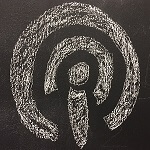
Rather listen to our podcast on Ed Cals?
With 2017 right around the corner, there couldn’t be a better time to address editorial calendars. Not the kind that map out what an organization will cover within its own blog and social media. Rather, the old school “Ed Cals” as we like to call them, which were most likely the first type of editorial calendar ever created.
The majority of magazines, trade journals, larger newspapers and many websites utilize editorial calendars to plan the topics they’ll cover within the year. They represent a window into future news, thus offering PR pros a hint into how they can garner coverage. With careful planning and the right pitch, some might consider future PR coverage a sure thing when armed with abundant editorial calendars.
Let’s examine what Ed Cals are, how to get your hands on them and how to make them work for you.
What are Ed Cals?
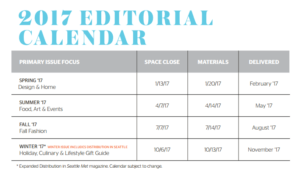 Editorial calendars are a roadmap of stories that help keep the editorial teams organized. But their main function is to help the advertising department sell ads. Pairing advertisements with related editorial content creates a more seamless sales pitch. For example, if a restaurant is told that all of their competitors will be advertising within the Top Restaurants special section, it’s harder to say no. Of course that restaurant will pine after appearing next to their competitors with their own ad.
Editorial calendars are a roadmap of stories that help keep the editorial teams organized. But their main function is to help the advertising department sell ads. Pairing advertisements with related editorial content creates a more seamless sales pitch. For example, if a restaurant is told that all of their competitors will be advertising within the Top Restaurants special section, it’s harder to say no. Of course that restaurant will pine after appearing next to their competitors with their own ad.
Where can you find Ed Cals?
Since editorial calendars are so strongly utilized by advertising departments, they are typically found in each outlet’s online advertising page. Within the advertising page, the Ed Cals are often hidden within the outlet’s Media Kit — an extensive document detailing everything you could possibly ever want to know about a certain outlet, including circulation numbers, demographic information and hopefully its editorial calendar. The Media Kit’s main purpose is to drum up advertising customers.
You don’t want to buy an ad?!?
I don’t blame you with access to this golden nugget! Everyone gets that PR pros don’t want to buy an ad, but media outlets make it hard on us by hiding one of our most valuable resources in their advertising collateral. If you can’t find the Ed Cal online, simply ask the advertising contact for it. While this shouldn’t come with strings attached, prepare yourself for an advertising pitch. There’s no harm in listening, just don’t take up too much of their time. You never know what future help this advertising contact may extend, but don’t make any promises you can’t keep. You’re free to hint that you’re sorting out your budget or that you’ll pass along their info to your advertising manager.
How do you organize the Ed Cals?
Upon culling through each Ed Cal and flagging the appropriate topics, take steps to organize the mountain of information that could result. I am in love with Excel, so I input all of the opportunities into a sheet for each client. Other groups may want to use collaborative tools such as Sharepoint, Google Calendar/Sheets, or Trello.
For Veracity’s purposes, all the information about each opportunity would go into Excel, including the following:
- Media Outlet
- Coverage Topic & Details
- Deadline (you’ll have to pad the advertising deadline appropriately for editorial, we’ll get into this below)
- Issue Date (when the topic you’re pitching will run)
- Contact Name & Info (If this isn’t in the Ed Cal, leave this part blank and come back to it upon commencing more research)
- Status Report (what’s happening with each pitch, we’ll get into this below)
When do you send Ed Cal inquiries?
Sorry, your work is far from over yet. The most important part — inputting your pitch deadlines into your personal work calendar — still needs to happen. Along with inputting the deadlines into Excel, we set reminders through Google Calendar. Use whatever tool you wish for this, just don’t miss the deadline! If you are a procrastinator like me, give yourself plenty of lead time, but don’t make your deadlines so irrelevant that you ignore them completely (not proud to say that I am speaking from experience here).
While the tried and true PR professional will get to know their press targets, here is a rough outline of when to send pitches. Some trial and error will help you refine this timeline to match your press friends’ exact needs.
- National monthly magazines, like Real Simple and Martha Stewart Living: Pitch 6 – 5 months ahead.
- Trades & Verticals: Pitch 3 – 2 months ahead.
- Regional monthly magazines, like Portland Monthly: Pitch 3 – 2 months ahead.
- Weeklies: Pitch 6 – 3 weeks ahead for a special section.
- “Short lead” publications, like daily newspapers: Pitch 6 – 3 weeks ahead (even though it’s a daily, you’re erring on the side of caution for a special section).
What do you pitch?
If you’ve been working in the same industry for a time, you’ll learn what works and what doesn’t. You can also gauge what you need to pitch by reading all the info about the topic listed in the Ed Cal. But here are 3 types of pitches to send with Ed Cal inquiries:
- Offer up insight: For our methylsulfonylmethane manufacturer, Bergstrom Nutrition, we simply send a pitch asking if the press would like any insight from the company’s executives on a particular article that might fit. We then include any compelling information, like a new study or science that might align with the topic to pique their interest.
- Offer to write the article: We might ask if they’d like an article written by our client that matches the topic. We then include any qualifying information as to why our source would be considered an expert on that particular topic, along with links to past writing samples if possible. This is mainly for trades and verticals.
- Send a press release or blog post: If you happen to have a press release or blog post ready on the topic, you might as well send that along with a pitch mentioning that some or all of the information could be used in the article they’re planning. Drop a hint that you might create something special just for them.
After the pitch?
Be sure to record everything you’ve done (emails sent, messages left) and all of the communications back from press in your “status” section of the Excel. This includes any insight that might help your future pitches. No’s are just future yes’s in disguise if you pay attention to any reasoning or redirection from the press.
If we haven’t heard back from a contact, we’ll typically follow up just one more time depending on how hard up we are for news. If we’ve been getting a lot of news lately around this particular topic we may give it a rest. However, if our research is telling us that our news should most definitely be included, we’ll dig a little deeper, either by confirming that we’ve got the right contact or readjusting our pitch, if necessary.
The 2017 editorial calendars should be out already, so get a jump on your yearly planning while everyone else is busy with the holidays. Ed Cals can serve as a starting point from which the rest of your content plan emerges. Not only will you have some timely, newsworthy topics deemed valuable by the press, you could possibly reach beyond your current audience if the press picks up any of your materials. Remember that anything you send to the press can be converted into a different type of content. Media pitches can be transformed into social posts, press releases can be revised into blog posts and white papers can be converted into op-eds. So what are you waiting for?
![Ed Cals Turn Uncertain PR into Sure Thing [Podcast]](https://www.veracityagency.com/wp-content/uploads/ChalkTalk-Ed-Cals-750x500-1.jpg)
by Amy Rosenberg | Dec 19, 2016 | Podcast, Public Relations, Resources, Social Media
How to get, organize and use editorial calendars for PR results. Amy and Connor explain the benefits of using editorial calendars to pitch stories to print and online publications.
For more details see the blog post Turning Uncertain PR Coverage into a Sure Thing.

by Amy Rosenberg | Oct 27, 2015 | Amy Talk, General, Posts, Public Relations
The chronicles of a runner’s pursuit in business can be interesting to examine. There is the sprinter who catapults to the finish line just seconds after the shotgun blasts. The 800 meter runner must strike a delicate balance between endurance and speed. And finally the distance runner utilizes the power of the mind to stay in it for the long haul.

I’d never be able to find the strength needed to speed through the shorter distances. And I find the 800’s combination of speed and endurance to be downright excruciating. Even though I’ve always been a distance runner, in school I wasn’t even good at the longest distance (3 miles), often coming in towards the back of the pack. It wasn’t until I was a young adult that I realized those distances were too safe for me. I needed the real distance of marathons.
It seems that going the distance has been my motto with everything in life, especially business. Just like there are many types of runners, there are also many styles of entrepreneurship. I’m not saying that one is better than another; it’s just interesting to compare and contrast the different types.
The speed racer tackles business — setting it up at breakneck speed, powering through like a maniac to ensure its success and selling it in just a few years. The middle distance entrepreneur combines a healthy mix of qualities that protect them from getting too sidetracked, letting a strong vision map an uncomplicated course.
And now we arrive at the qualities of the endurance entrepreneur. While some may admire us, I can admit there is a hint of pathetic quality to being endurance-minded. We’re faulted for letting our analytical side take over too often, miring in the details, strategizing every opportunity or challenge that presents itself.
But our strength is that we are trustworthy. Most of us are in it for the long haul because we have a love for what we do and whom we service. We won’t leave the cause for the shiny new thing. We are with you until the bitter end. But we tend to grow slowly because our love for the work lets us get a little too wrapped up into the business of the day.
However, loving what you do makes it easier for people to buy into our business. Clients, investors and staff can sense how you’ve made your work an integral part of your life and are more willing to put their hearts and heads with yours.
If you want to operate a marathon-style business, an interesting way to psyche yourself up is considering the race itself. Match your growth as if you’re attempting to get through 26 miles of straight running.
My thoughts on marathon mileage are really straight forward. Breaking the full 26. 2 miles into chunks makes the unfathomable distance much more approachable. Here is how I do it:
Race Preparation:
This is the most important part! You couldn’t even consider lacing up your shoes on race day without the grueling training runs that eat up half your weekend. But the little things can be just as important, like breaking in the right shoes and selecting the most uplifting playlist. Without all of this there is no race to be had.
How does this relate to business? The preparation is done through building upon the experiences you’ve already had, tapping into resources and mentors along the way. Other details like studying the competition or investigating loan options can help set the tone of your overall direction.
Miles 1-6:
 Forget about these. They don’t count. Your race preparations have made it so you’re not even breaking a sweat. The marathon doesn’t even begin until you’ve finished these piddly miles.
Forget about these. They don’t count. Your race preparations have made it so you’re not even breaking a sweat. The marathon doesn’t even begin until you’ve finished these piddly miles.
How does this relate to business? Writing off the early stages offers you the kind of bold attitude necessary for risk taking. View early failures as mini successes because you’ll get the important lessons over with.
Looking back, I don’t know that we took many risks in the beginning. Maybe we were too safe? It seems that we just continued to practice what we were good at, like a slow steady turtle, faithfully shuffling on. But when I am faced with difficult decisions now, I only have to remember the biggest risk of all (when Mike quit his digital marketing gig to join Veracity full time) and everything else pales in comparison. I’m glad we got that out of the way when it “didn’t count.”
Miles 7-10:
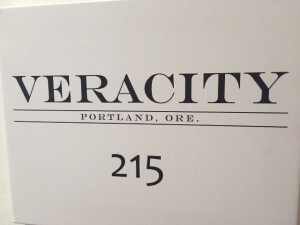 This is your warm up.
This is your warm up.
How does this relate to business? This blog post was inspired by our move into our very first office. As we signed the lease I chuckled as I recognized this next phase in our business. It wasn’t that we were spending money on a lease that was important. Having our name on the door meant something. Experiencing the new-found energy bubbling up in our new space I realized we had only just begun. We were at mile 7.
Miles 10-13:
It’s preferable to go into “turn off” mode, go through the motions and meditate into your body, your music, your breathing — lean into the relaxing state of the running.
How does this relate to business? Since we haven’t been here yet I can only guess that this is when you would get into the flow of your business. Your warm up helped work the kinks out so you can build a steady foundation to hold future growth. Be happy, you’ve hit your stride!
Mile 14:
WOW! Before you knew it you were half way done. Way to go! Party Time!
How does this relate to business? While most of us don’t know our business’ true half way points, this is a healthy reminder to keep track of goals along the way. Every time I review our business plan and see that we’re on track I feel a sense of relief and pride.
Miles 15-18:
Things are starting to get serious, especially in the Portland Marathon where we are greeted with the grueling hill of the St. John’s Bridge. We know that this is where the true willpower kicks in, serving as a testament to our strength. We must push through and meet the other side of the miles.
How does this relate to business? Again, new territory here but I’d imagine as businesses grow their challenges increases. As you’re trudging up that hill don’t lose sight of the original dedication and vision that brought you here.
Miles 18-20:
We’re told not to train too far past mile 20 so we don’t know what pain there is to come. We don’t focus on what happens past mile 20 knowing we just have to get there first to find out. Hopefully we have planned ahead and organized some cheerleaders to push us through these mile points.
How does this relate to business? Possibly here is where the support of a solid team comes into play the most. You truly can’t go it alone, even in a solo sport, and when you’re at your breaking point sometimes the only thing that will keep you going is a helping hand.
Miles 20-23:
 What happens here is as much up to fate as it is about your mindset and willingness to go the distance. They tell us not to train too far past mile 20 so we stay injury free. But I believe there is some notion of keeping your mind open and not too scared of this final length.
What happens here is as much up to fate as it is about your mindset and willingness to go the distance. They tell us not to train too far past mile 20 so we stay injury free. But I believe there is some notion of keeping your mind open and not too scared of this final length.
How does this relate to business? This might be a good point to remember the ever-changing landscapes we are presented with. Competitors rise up, technology disrupts our marketplace and more. Rather than fretting about this ahead of time, roll with the punches and adapt to change.
Miles 24-25:
This part separates the women from the girls. Some girls cry, limp off the course, and call their Daddies for pick up. But the women persevere. We might be dragging our bleeding, leaden feet behind us but we are going to make it through the finish line even if we have to crawl. We know our Dads are already at the finish line waiting to pick us up — they’d rather not rescue us from the middle of our disaster.
How does this relate to business? This is where the rubber meets the road. You’ve made it this far. Don’t throw in the towel too early. The finish line is around the corner.
Mile 26:
Thank God! We are almost there! Who thought of this insane amount of mileage anyway?
How does this relate to business? When we feel proud to review the legacy we’ve left behind we’ll know we’ve reached the ending point and are excited to see what’s on the other side.
The last .2: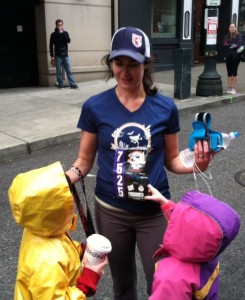
Really!?! Is this necessary. This pure torture.
How does this relate to business? It may be torture for some of us to give up something we’ve worked so hard on, almost like another child or another part of us, but we know it’s best for us and everyone involved. As we unlace those shoes and store them away for safe keeping, we open a different door, questionably looking at the new equipment inside — golf clubs, art supplies or a new baby blanket.
At the end of the day we’re all just pounding the pavement.
Images used under the creative commons license CC0 1.0, 2.0 & 3.0.

by Mike Rosenberg | Feb 15, 2015 | Agency Life, Client Work, Digital Marketing, General, How To, Posts, Public Relations, Resources, Social Media
An attendee of a presentation I gave emailed me the following:
Do you think this [HARO] is an effective means of getting known? Do most of your customers write their own responses or do you help them with this? I guess my question stems from a concern around capacity and the best use of scarce resources (me).
This is my basic response, with some added commentary:
I think it depends on the business and the value of the publication/website.
You have to start asking yourself some questions:
- Is it something your target customer reads?
- Will the story be relevant to your company or industry?
- Does the website have “authority” in your industry or target markets/verticals?
- What is the likelihood of a story running and if it does, will I get a link as well?
If the answer is yes to the above, it can be effective, but you also have to consider your time and resources as you mentioned. Sometimes you can edit content that you have already created to fit with specific results. Sometimes you have to create something new. If you are developing content already for editorial calendars, bylined articles, blog posts, social media, etc. often times a lot of the work is already done.
The other factor is the SEO value that can be gained by being included in stories like these…links for relevant “news” sites are very valuable.
With our clients, we tend to find, vet and create the responses for them, with their input of course as they typically have more expertise in their industry that we do.
Using the example he sent, we’d probably have a short conversation/interview with him and then write a response – assuming it was an outlet we deemed valuable. Of course it depends on the level of engagement.
Regarding this specific opportunity.
Here is what I advised him to do:
- Determine if he can come up with a good answer to the question in a timely fashion (do you have time). If no, drop it. If yes…⇒
- Look at the website (which is usually in the HARO post and if it is not a quick search of the requesting reporter should give you an idea). Is it relevant to your market and/or potential clients. If not drop it. If yes…⇒
- Write a response (make sure to follow any specific direction and include a link to your website) and email it to him.
- Note that attachments do not get passed forward when you respond through HARO.
- If he does use your response, check to make sure you are quoted correctly and that he included a link (if he didn’t ask for one).
In summary, HARO can be an effective marketing tool, but there is also a lot of junk. So make sure you are going to reach a target audience in a quality outlet before putting forth too much effort.
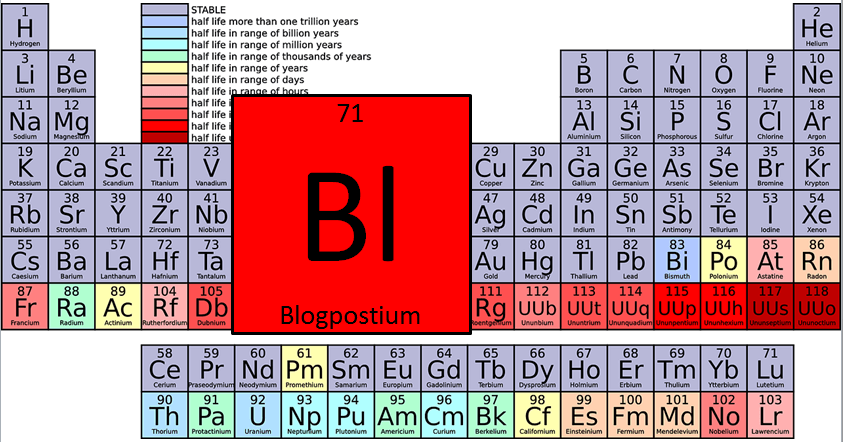
by Mike Rosenberg | Jan 28, 2015 | Digital Marketing, How To, Posts, Public Relations, Resources, Social Media
There are a ton of blog posts about…well, blog posts. What’s the perfect length, the ideal structure, and the must have elements?
Based on our experience and the insight garnered from many of those other posts, here’s our list (bearing in mind some industry-specific caveats):
Audience
Who are you writing for? Define in general and specifically for each post. Use the personas you’ve developed (need help, Mike King did a great post on Moz), let one of them (one of your target audience members that is) read it if you can.
Here’s a sample of the four potential audiences for a health insurance provider client:
- Members/Subscribers/Current Customers
- What do they care about?
- They can be your biggest advocates
- Potential Members/General Public
- Educate, inform, enlighten
- Brokers/Re-sellers
- Media/Influencers
- Be a resource
- Create a link opportunity
Headline
Length
Headlines should be one to two lines (lines as in the width of a page, not lines as in full sentences), the beginning and the end are most important as readers absorb the first three and last three words of headlines. Here are some other quick tips:
- About 55 characters are ideal for SEO; otherwise it will get truncated (…)
- If you use WordPress use Yoast SEO Plugin
Strategies
What should the headline focus on? Here are some ideas for a destination wedding planning client:
- Ask or answer a question – “What Do You Need to Know About Destination Weddings?”
- How to – “How to Negotiate a Room Block”
- Use numbers – “5 Tips for Finding a Florist in Cabo”
- Reference your audience – “Brides to be need to know…”
- Surprise – “What If Nobody Comes to Your Wedding?”
- News – “Tsunami Wedding! How to Prepare for the Unexpected”
Formula: Numbers + Adjective + Target Keyword + Rationale + Promise = Ultimate Headline
Hook
- Tell a story – the headline will get their attention, a story will make a reader continue
- Personal anecdotes are appreciated
- Can be personal about someone else (politician, celebrity, influencer)
Layout
Image placement
- Place image at top (we prefer top right along the first paragraph if there is a lot of copy in the opening) to make the initial paragraph seem shorter.
- And/or, use a larger font for opening paragraph so it is easier to read.
- Multiple images are good to break up content and provide alternatives for social sharing
Short paragraphs are best
- One idea or thought per paragraph
- Not “text book” or AP Style writing; readers expect to be able to scan and digest quickly online
Use subheads
- Break up content using subheads; people scan while reading on the internet
- Use header tags (H1 for Title/Headline; H2’s and H3’s for subheads)
- These can also provide readers an easily sharable call out to use while sharing socially (see Share-ability below)
Want more details? Listen to the PR Talk episode about this post
Infrastructure
Call to action
Social share buttons
- Only use/show the most relevant ones (e.g. just because you could have a button to easily share on MySpace, you don’t need it and it is just confusing/overwhelming)
- Have an obvious “tweetable” quote
- Can even call out “Tweet this quote” or use plugin (see Share-ability below)
Images (see Layout above)
Simple, sharable, searchable URLs
- Short with keywords from headline/title
Bio – have a short bio of the author; people like to know who is “talking” to them
- Some recommend using the sidebar, but at the bottom is fine too (with headshot)
- A short summary bio that links to a full bio works well
Newsletter Signup Form
Email newsletter signup form should be in sidebar or some like to have it permanently across the top (moves down with you as you read)
Sidebar, preferably on the right. Potential items include:
- Recent Posts
- Top Posts
- Blog Categories
- Author bio
- Email newsletter sign-up
- Social Media profile links
- Offer (white paper, case study)
- Quick value prop
- Contact form
- Quick “About Us”
- Tags
Timing
Day of the week?
- Experiment to start, then follow the data
- Social media stats can provide initial insight (i.e. when your followers are engaged on Facebook)
Time of the day?
- Experiment to start, then follow the data
- Social media stats can provide initial insight (i.e. when your followers are engaged on Facebook)
Post posting and social promotion
- Schedule social promotions – at least three
i. At time of post
ii. X hours later (e.g. six hours after initial publishing, or the next day)
iii. X days later (e.g. if you typically post in Tuesday, promote again on Friday or the following week)
Share-ability
Be sure to have easily shareable elements in your posts
- A “tweetable” quote
- Pull out quotes to break-up content and provide easy to share tidbits, like this from Buffer
- Can be integrated into blog
A tweetable quote can be a key element of a good blog post
Click to Tweet
- Images that will encourage sharing and reading
Length
Not too short; but not too long (which of course is a relative thing).
Ideal blog posts are 1,000 to 1,500 words
- Under 500 is too short
- Longer posts (long form content) is not bad, but need you need to break it up as it can be intimidating. Social sharing starts to go down after about 1,500 words
Should take about 7 minutes to read
Links
http://blog.bufferapp.com/perfect-blog-post-research-data
http://www.koozai.com/blog/search-marketing/content-marketing-seo/anatomy-perfect-blog-post/
http://www.quicksprout.com/2014/07/07/11-essential-elements-of-a-perfect-blog-design-a-data-driven-answer/

by Amy Rosenberg | Jul 14, 2014 | Digital Marketing, General, Posts, Public Relations
If you read the blog post about how we decided to change the company name to Veracity, you might have noticed that I’m a bit of a Hemingway freak. In the post I mentioned that I would explore how themes of luck and discipline, which are consistently used in his memoire “A Moveable Feast,” relate to the making of a marketing business.
Basically I just liked what he said about how the two related to writing and I was trying to cram it into the original post and it wasn’t working. I had to focus on the point I was trying to make, which was that the message about true and honest writing was important and related to us and was how the name Veracity emerged.
 I came up with the name Veracity in a café of sorts in our neighborhood, close to our home and work, where I must have been having good luck. Which is fitting because Hemingway often notes that he found luck at various times throughout his work day—especially while writing at certain Parisian cafes.
I came up with the name Veracity in a café of sorts in our neighborhood, close to our home and work, where I must have been having good luck. Which is fitting because Hemingway often notes that he found luck at various times throughout his work day—especially while writing at certain Parisian cafes.
Beyond superstitious luck, like how he carried a rabbit’s foot in his pocket while working, he writes mostly about the luck that we have all tried to experience while working at coffee shops. This luck is all about flow. The music is at the right volume, the neighbors are not noisy, the chairs are comfortable and the coffee is good—you are able to work well without distraction.
But unfortunately it doesn’t always go this way. Hemingway comically recounts what distractions can do to creatives on page 91:
Some days it went so well that you could make the country so that you could walk into it through the timber to come out into the clearing and work up onto the high ground and see the hills beyond the arm of the lake….[the paragraph goes on to set the scene of what he’s writing about].
Then you would hear someone say, ‘Hi Hem. What are you trying to do? Write in a café?’
Your luck had run out and you shut the notebook. This was the worst thing that could happen. If you could keep your temper it would be better but I was not good at keeping mine then and said, ‘You rotten son of a bitch what are you doing in here…?’
I’m sure we have all too often experienced this, but hopefully we were more polite. When we serendipitously bypass the distracting coffee shop to settle in at a quiet café, is it pure luck? Or if we happen to take off our headphones just in time to overhear the coffee shop owner talking of needing someone to market her expansion, is that pure luck?
Of course not. We walked into the coffee shop already prepared. Consider how Hemingway’s themes of discipline come into play in the second chapter.
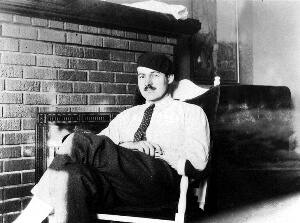 When I had worked well, and that needed luck as well as discipline, [it] was a wonderful feeling and I was free to walk anywhere in Paris.
When I had worked well, and that needed luck as well as discipline, [it] was a wonderful feeling and I was free to walk anywhere in Paris.
I always worked until I had something done and I always stopped when I knew what was going to happen next. That way I could be sure of going on the next day.
Attempting to get a marketing company off the ground is definitely not the same as writing masterpieces, but I just love how he described his major artistic endeavors like just another day at work. He worked hard at it, just as we all should work hard at our jobs, and we can learn from his example.
This last quote of Hemingway’s, said to his wife after a successful stint at the race track, just about sums up how a mixture of good luck and steadfast tenacity can come into play in all of our professional lives, whether you are a writer, NBA player or launching a marketing company.
‘You said we were lucky today. Of course we were. But we had very good advice and information.” (pg. 56)
 Images used under this Creative Commons License.
Images used under this Creative Commons License.

 Editorial calendars are a roadmap of stories that help keep the editorial teams organized. But their main function is to help the advertising department sell ads. Pairing advertisements with related editorial content creates a more seamless sales pitch. For example, if a restaurant is told that all of their competitors will be advertising within the Top Restaurants special section, it’s harder to say no. Of course that restaurant will pine after appearing next to their competitors with their own ad.
Editorial calendars are a roadmap of stories that help keep the editorial teams organized. But their main function is to help the advertising department sell ads. Pairing advertisements with related editorial content creates a more seamless sales pitch. For example, if a restaurant is told that all of their competitors will be advertising within the Top Restaurants special section, it’s harder to say no. Of course that restaurant will pine after appearing next to their competitors with their own ad.

![Ed Cals Turn Uncertain PR into Sure Thing [Podcast]](https://www.veracityagency.com/wp-content/uploads/ChalkTalk-Ed-Cals-750x500-1.jpg)


 Forget about these. They don’t count. Your race preparations have made it so you’re not even breaking a sweat. The marathon doesn’t even begin until you’ve finished these piddly miles.
Forget about these. They don’t count. Your race preparations have made it so you’re not even breaking a sweat. The marathon doesn’t even begin until you’ve finished these piddly miles. This is your warm up.
This is your warm up. What happens here is as much up to fate as it is about your mindset and willingness to go the distance. They tell us not to train too far past mile 20 so we stay injury free. But I believe there is some notion of keeping your mind open and not too scared of this final length.
What happens here is as much up to fate as it is about your mindset and willingness to go the distance. They tell us not to train too far past mile 20 so we stay injury free. But I believe there is some notion of keeping your mind open and not too scared of this final length.




 I came up with the name
I came up with the name 



